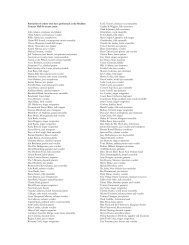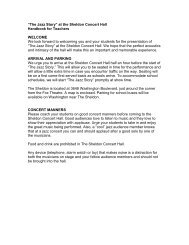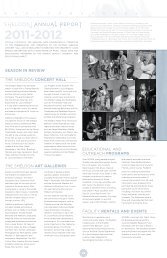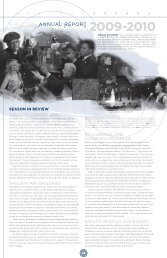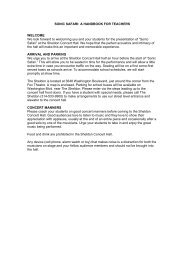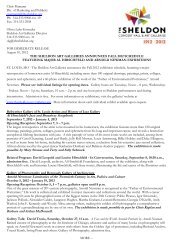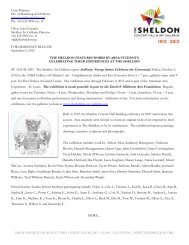C l if f o r d R .M a r t in - Sheldon Concert Hall
C l if f o r d R .M a r t in - Sheldon Concert Hall
C l if f o r d R .M a r t in - Sheldon Concert Hall
Create successful ePaper yourself
Turn your PDF publications into a flip-book with our unique Google optimized e-Paper software.
of the pen as Japanese Foreign M<strong>in</strong>ister Mamoru Shigemitsu; General<br />
Yoshijiro Umezo, Chief of Staff, Japanese Army; General Douglas MacArthur;<br />
and Admiral Chester W. Nimitz each signed and witnessed the surrender<br />
agreement. Although several other photographers and filmographers were<br />
on duty that day, Mart<strong>in</strong>’s images have been found to be the most widely<br />
published. (Figure 4)<br />
A remarkable historic document, the collection of photographs, pr<strong>in</strong>ted and<br />
sent home to loved ones as events unfolded <strong>in</strong> the last years of the war <strong>in</strong> the<br />
Pac<strong>if</strong>ic, are also a testament to Mart<strong>in</strong>’s savvy and sensitive eye. Though<br />
Mart<strong>in</strong> dut<strong>if</strong>ully captured the images that he was assigned to record, he also<br />
Notes<br />
1<br />
Michel Frizot, editor, A New History of Photography, (Cologne: Konemann, 1998), 144.<br />
2<br />
Susan D. Moeller, Shoot<strong>in</strong>g War: Photography and the American Experience of Combat (New York: Basic Books, Inc., 1989), 115.<br />
3 Edward Steichen, A L<strong>if</strong>e <strong>in</strong> Photography, Garden City (New York: Doubleday & Company, Inc and New York, New York: The Museum of Modern Art,<br />
1963), 223. Steichen’s team <strong>in</strong>cluded <strong>in</strong>cluded Wayne Miller, Charles Kerlee, Fenno Jacobs, Horace Bristol, Victor Jorgensen, Barrett Gallagher, and<br />
John Swope.<br />
4 The image can be found <strong>in</strong> L<strong>if</strong>e magaz<strong>in</strong>e, (March 5, 1945), 38.<br />
Sources<br />
Frizot, Michel, editor. A New History of Photography. Cologne: Konemann, 1998.<br />
Henisch, He<strong>in</strong>z K. and Bridget A. Henisch, The Photographic Experience 1839-1914: Images and Attitudes. University Park, Pennsylvania:<br />
The Pennsylvania State University Press, 1994.<br />
Lew<strong>in</strong>ski, Jorge. The Camera at War: A History of War Photography from 1848 to the Present Day. Secaucus, N.J.: Chartwell Books, Inc., 1978.<br />
Moeller, Susan D. Shoot<strong>in</strong>g War: Photography and the American Experience of Combat. New York: Basic Books, Inc., 1989.<br />
Steichen, Edward Steichen. A L<strong>if</strong>e <strong>in</strong> Photography. Garden City, New York: Doubleday & Company, Inc and New York, New York: The Museum<br />
of Modern Art, 1963.<br />
W<strong>in</strong>kler, Allan M. The Politics of Propaganda: The Office of War Information 1942-1945. New Haven: Yale University Press, 1978.<br />
3648 Wash<strong>in</strong>gton Boulevard, St. Louis, Missouri 63108<br />
Telephone: 314.533.9900 Fax: 314.533.2958<br />
Website: www.thesheldon.org/galleries.asp<br />
Gallery Hours:<br />
Tuesdays and Thursdays, Noon to 8 p.m.<br />
Wednesdays and Fridays, Noon to 5 p.m.<br />
Saturdays, 10 a.m. to 2 p.m.<br />
One hour before <strong>Sheldon</strong> concerts and dur<strong>in</strong>g <strong>in</strong>termissions. Cl<strong>if</strong>ford<br />
COVER, CLOCKWISE FROM TOP: Crash Land<strong>in</strong>g off Luzon, February, 1945, gelat<strong>in</strong> silver pr<strong>in</strong>t, collection of the photographer.<br />
Portrait of Cl<strong>if</strong>ford Mart<strong>in</strong>, c. 1943-1945, gelat<strong>in</strong> silver pr<strong>in</strong>t, 10 x 8 <strong>in</strong>ches, courtesy of the photographer; First WAC’s <strong>in</strong> Guam,<br />
c. 1945, gelat<strong>in</strong> silver pr<strong>in</strong>t, 10 x 8 <strong>in</strong>ches, collection of the photographer.<br />
★<br />
expanded on his mission and <strong>in</strong> the process produced a body of work that<br />
can help us to imag<strong>in</strong>e the unimag<strong>in</strong>able.<br />
These and many other images by Mart<strong>in</strong> and other Navy photographers, still<br />
uncredited, can be found <strong>in</strong> a number of government archives <strong>in</strong>clud<strong>in</strong>g two<br />
ma<strong>in</strong> repositories: the Library of Congress and the National Archives <strong>in</strong><br />
Wash<strong>in</strong>gton D.C. They rema<strong>in</strong> <strong>in</strong> the public doma<strong>in</strong>.<br />
Olivia Lahs-Gonzales<br />
Director<br />
The <strong>Sheldon</strong> Art Galleries<br />
The exhibition is organized by the <strong>Sheldon</strong> Art Galleries and is drawn<br />
from the collection of Cl<strong>if</strong>ford R. Mart<strong>in</strong>. All images are <strong>in</strong> the public<br />
doma<strong>in</strong> and are official Navy photographs.<br />
The exhibition and publication are made possible by Ellen Curlee.<br />
R. Mart<strong>in</strong><br />
THE<br />
SHELDON<br />
ART<br />
GALLERIES
Photography has recorded conflict s<strong>in</strong>ce the early days of its <strong>in</strong>vention.<br />
Dat<strong>in</strong>g from around 1846, the first-known war photographs were made<br />
dur<strong>in</strong>g the Mexican-American War. These, and ones made <strong>in</strong> Crimea by the<br />
well-known British photographer Roger Fenton <strong>in</strong> the mid-1850s, record only<br />
still subjects s<strong>in</strong>ce lengthy exposure times would not have facilitated images<br />
of action. In America, the Civil War also brought forth many photographers<br />
eager to provide souvenirs and mementos. Capta<strong>in</strong> A. J. Russell was an<br />
official Army photographer placed <strong>in</strong> charge of document<strong>in</strong>g the U.S. Military<br />
Railroad, and Mathew Brady, a civilian, employed a large team of photographers<br />
<strong>in</strong>clud<strong>in</strong>g such lum<strong>in</strong>aries as Alexander Gardner, Timothy O’Sullivan<br />
and George Barnhard to create a catalogue of over 7,000 photographs. 1 The<br />
cameras often used on these occasions were mammoth <strong>in</strong> size and required<br />
a wagon full of equipment, <strong>in</strong>clud<strong>in</strong>g hundreds, even thousands of glass<br />
plates, a portable darkroom and chemicals to be transported on site.<br />
Figure 1<br />
By World War I, smaller cameras and faster films made it possible to capture<br />
not only the aftermath of the war, but the battle itself. The War brought<br />
mechanization and new technologies to all levels of combat. When the U.S.<br />
entered the conflict <strong>in</strong> 1917, cameras <strong>in</strong>cluded the 4 x 5- <strong>in</strong>ch Graflex and<br />
Speed Graphic. These still employed glass plates, however some 3 1 ⁄4 x 5 1 ⁄ 2<br />
roll film cameras were also <strong>in</strong> use. It was dur<strong>in</strong>g World War I that the<br />
military became <strong>in</strong>creas<strong>in</strong>gly aware of the implications and possibilities<br />
of photography. For the military, photography was an <strong>in</strong>valuable tool,<br />
allow<strong>in</strong>g the analysis of a variety of operations <strong>in</strong>clud<strong>in</strong>g aerial reconnaiss-<br />
ABOVE (Figure 1): Iva Toguri (“Tokyo Rose”), Yokohama,<br />
September, 1945, gelat<strong>in</strong> silver pr<strong>in</strong>t, 10 x 8 <strong>in</strong>ches, collection of the photographer.<br />
RIGHT (Figure 2): Children with Cart Made of Shell, Guam, 1945,<br />
gelat<strong>in</strong> silver pr<strong>in</strong>t, 8 x 10 <strong>in</strong>ches, collection of the photographer.<br />
★ ★<br />
ance and the after-effects of shells and m<strong>in</strong>es. Initially, only photographers of<br />
the Army Signal Corps were sanctioned to take pictures <strong>in</strong> sensitive<br />
battle-front areas, however by late 1917, restrictions were rolled back and<br />
authorization was given to open more areas to the press. 2 By World War II,<br />
photographic technology had improved further and even more possibilities<br />
for record<strong>in</strong>g action were available to photographers.<br />
Born <strong>in</strong> St. Louis <strong>in</strong> 1920, Cl<strong>if</strong>ford Russell “Marty” Mart<strong>in</strong> enlisted <strong>in</strong> the<br />
United States Navy <strong>in</strong> February of 1943, leav<strong>in</strong>g his position as a draftsman<br />
<strong>in</strong> the gun turret design division at Emerson Electric <strong>in</strong> St. Louis. After basic<br />
tra<strong>in</strong><strong>in</strong>g <strong>in</strong> Farragut, Idaho, where his skills as a photographer became<br />
evident, he was sent to specialty tra<strong>in</strong><strong>in</strong>g <strong>in</strong> photography <strong>in</strong> Pensacola,<br />
Florida, where he learned to work with a variety of cameras, <strong>in</strong>clud<strong>in</strong>g the<br />
4 x 5 -<strong>in</strong>ch Speed Graphic. From Pensacola, he was sent to Anacostia,<br />
Virg<strong>in</strong>ia, where Edward Steichen headed up a special branch of the Navy<br />
photography section. Steichen, who had served as an Army Signal Corps<br />
photographer dur<strong>in</strong>g World War I and was almost retirement age, had been<br />
commissioned by the Navy to assemble a crew of men to “photograph the<br />
story of Naval aviation.” 3 From tra<strong>in</strong><strong>in</strong>g at Anacostia, Cl<strong>if</strong>ford Mart<strong>in</strong> was the<br />
only student to be sent to the Polaroid Lab <strong>in</strong> Massachusetts for additional<br />
tra<strong>in</strong><strong>in</strong>g with Professor Edw<strong>in</strong> Land. From this f<strong>in</strong>al tra<strong>in</strong><strong>in</strong>g, Mart<strong>in</strong> was first<br />
billeted to a ship <strong>in</strong> the Atlantic Ocean but then transferred to Hawaii to<br />
record the salvage from the aftermath of the attack on Pearl Harbor.<br />
He spent the rest of the war <strong>in</strong> the Pac<strong>if</strong>ic Theatre.<br />
Dur<strong>in</strong>g his tour of duty, Mart<strong>in</strong> was able to make pr<strong>in</strong>ts for himself and to<br />
send home to his family after military censors approved them for release.<br />
Mart<strong>in</strong>’s collection, which numbers well over 350 photographs, is a valuable<br />
document of one Navy sailor’s experiences of the war <strong>in</strong> the Pac<strong>if</strong>ic Theatre.<br />
Unlike Steichen’s team of photographers or the staff photographers for Yank<br />
and Stars and Stripes, Navy photographers did not enjoy the benefits of<br />
photo credits when their work was published. Few official Navy photographs<br />
bear the names of the photographers when seen <strong>in</strong> pr<strong>in</strong>t and the pr<strong>in</strong>ts<br />
themselves often only bear the names of the censors who passed them<br />
for publication.<br />
Mart<strong>in</strong> spent many months aboard aircraft carriers, transports and on<br />
Guam. Surpris<strong>in</strong>gly, Mart<strong>in</strong>, like the members of Steichen’s team, enjoyed<br />
a great deal of freedom to choose his subjects as long as his official<br />
duties were completed. Assigned to Admiral Nimitz’s headquarters<br />
Figure 2<br />
(CINCPAC: Commander <strong>in</strong> Chief Pac<strong>if</strong>ic Area Command), Mart<strong>in</strong>’s<br />
enthusiasm and goodwill for the job earned him a position as Nimitz’s<br />
personal photographer. He was called upon frequently by the Admiral to<br />
record his important career moments such as military decorations,<br />
Nimitz’s radio broadcast announc<strong>in</strong>g the Japanese capitulation, and the<br />
Japanese surrender ceremonies aboard the U.S.S. Missouri. Nimitz also<br />
honored Mart<strong>in</strong> by mount<strong>in</strong>g several of his photographs <strong>in</strong> his office.<br />
Aerial reconnaissance photographs, documents of land and sea battles<br />
like Iwo Jima, as well as day-to-day l<strong>if</strong>e on ship and land — both military<br />
and civilian — were also subjects of Mart<strong>in</strong>’s camera.<br />
The Pac<strong>if</strong>ic Theatre was vast and covered thousands of miles. Long<br />
stretches of boredom punctuated by shorter, <strong>in</strong>tense and hair-rais<strong>in</strong>g<br />
moments of combat constituted l<strong>if</strong>e aboard ship. Days were spent<br />
hopp<strong>in</strong>g from island to island, from campaign to campaign, but<br />
<strong>in</strong>-between, sailors enterta<strong>in</strong>ed themselves with games, costume parties<br />
and haz<strong>in</strong>g. Mart<strong>in</strong> was always happy to make portraits of his fellow<br />
seamen dur<strong>in</strong>g these times, as well as to record special visitors and<br />
other important events. He was on-hand to photograph the visit of war<br />
correspondent Ernie Pyle days before his death at Iwo Jima, the<br />
announcement of the Japanese surrender, and the arrest of Iva Toguri —<br />
also known as “Tokyo Rose.” Reveal<strong>in</strong>g his talent for captur<strong>in</strong>g the<br />
psychological nuances of the moment, Mart<strong>in</strong>’s brilliantly composed<br />
photograph of Toguri shows the delicate young woman surrounded by<br />
a maelstrom of military and press after her arrest by the American<br />
government for treason. (Figure 1) The case aga<strong>in</strong>st Toguri was later<br />
dropped after widespread <strong>in</strong>terviews were conducted and no witnesses<br />
could provide <strong>in</strong>formation that warranted the charge of treason that had<br />
been mounted.<br />
Dur<strong>in</strong>g his enlistment, Mart<strong>in</strong> also produced a sensitive study of the<br />
people and the war-torn landscape of Guam. In this body of work, he turned<br />
his camera to record the <strong>in</strong>habitants <strong>in</strong> the aftermath of the American<br />
liberation. His photographs show native Guamians mend<strong>in</strong>g nets,<br />
prepar<strong>in</strong>g leaves and wash<strong>in</strong>g clothes, and children play<strong>in</strong>g with toys<br />
constructed from the detritus of war. (Figure 2) Mart<strong>in</strong> also recorded<br />
the conditions of Japanese prisoners of war <strong>in</strong> American quarters.<br />
Seen <strong>in</strong> these photographs are the barracks where they slept and<br />
congregated, medical facilities and some of the cultural performances<br />
that they produced.<br />
Figure 4<br />
The most dramatic of the images <strong>in</strong> Mart<strong>in</strong>’s collection, however, are those<br />
shot dur<strong>in</strong>g the pitch of battle. One image of hundreds of ships advanc<strong>in</strong>g<br />
towards Iwo Jima <strong>in</strong> the <strong>in</strong>itial surge was published <strong>in</strong> L<strong>if</strong>e magaz<strong>in</strong>e. 4<br />
Another extraord<strong>in</strong>ary photograph, taken aboard a transport ship off<br />
Ok<strong>in</strong>awa, shows the air peppered with clouds of smoke from guns and<br />
bombs. (Figure 3) Others show Mar<strong>in</strong>es on land, stalk<strong>in</strong>g their adversaries<br />
on the ground and rout<strong>in</strong>g them out of their hid<strong>in</strong>g places with flame throwers.<br />
In this group, a number of photos show enemy dead and wounded<br />
American Mar<strong>in</strong>es. Censorship was tight before 1943 and restrictions were<br />
similar to those dur<strong>in</strong>g World War I. However <strong>in</strong> mid-1943, the military<br />
opened up the k<strong>in</strong>ds of photographs that could be published <strong>in</strong> the press to<br />
<strong>in</strong>clude images of American dead, though their faces were obscured out of<br />
respect for their families. Mart<strong>in</strong>’s images also record the dramatic moments<br />
of Japanese Kamikaze attacks and enemy ships under fire. Adept at aerial<br />
Figure 3<br />
photography, he also documented the terr<strong>if</strong>y<strong>in</strong>g aftermath of <strong>in</strong>cendiary<br />
bomb<strong>in</strong>gs of Tokyo and Naha, Ok<strong>in</strong>awa and the devastation left from the<br />
atomic bombs at Nagasaki and Hiroshima.<br />
In addition to scenes of battle, Mart<strong>in</strong>’s assignments also <strong>in</strong>cluded military<br />
<strong>in</strong>spections, ceremonies and light-hearted moments aboard ship when<br />
enterta<strong>in</strong>ers like Gene Autry and V.I.P.s like Eleanor and President Roosevelt<br />
visited. His most important event, however, was the sign<strong>in</strong>g of the surrender<br />
papers aboard the U.S.S. Missouri on September 2, 1945. From his ideal<br />
vantage po<strong>in</strong>t directly beside the sign<strong>in</strong>g table, Mart<strong>in</strong> recorded the strokes<br />
cont<strong>in</strong>ued on next page<br />
ABOVE (Figure 3): Untitled (Battle off Ok<strong>in</strong>awa), 1945, gelat<strong>in</strong> silver pr<strong>in</strong>t,<br />
8 x 10 <strong>in</strong>ches, collection of the photographer.<br />
LEFT (Figure 4): Surrender Ceremonies Aboard the U.S.S. Missouri, Admiral<br />
Chester W. Nimitz Sign<strong>in</strong>g, September 2, 1945, gelat<strong>in</strong> silver pr<strong>in</strong>t, 8 x 10 <strong>in</strong>ches,<br />
collection of the photographer.



